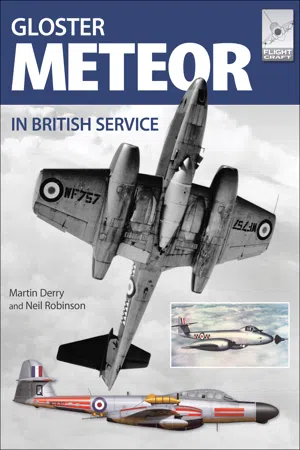
- 96 pages
- English
- ePUB (mobile friendly)
- Available on iOS & Android
eBook - ePub
Gloster Meteor in British Service
About this book
The Gloster F.9/40 was Britains first jet fighter and as the Meteor F.I became the first jet-powered aircraft of any description to enter service with the Allies in World War II. Several early Meteors were dispatched to Europe in the hope that 1945 might witness the first ever jet-on-jet combats between it and the much-vaunted German jets a contest which, in the event, was never to occur.Postwar, and the Meteor quickly became the backbone of the UKs day fighter defenses, progressing through successive Marks as it did so, until finally being replaced on the front line by later types during the mid-1950s. With their ever-adaptable airframe, two-seat Meteors became Britains primary night fighter too, serving for several years until replaced by the Gloster Javelin from the late 1950s onwards.With its operational career over, the Meteors adaptability and ruggedness was put to sterling use as an advanced trainer, the most obvious example of which was the T.7. As late as 1982, a handful of stalwarts were still soldiering on.Although space precludes a comprehensive history of such a prolific aircraft, it is hoped that both aviation enthusiasts and aircraft modelers may find some interesting examples in these pages, and sufficient inspiration to help them choose which color scheme to finish their latest Meteor model in.This latest addition to the FlightCraft range follows our well-established format in that it is split into three primary sections. The first covers the Meteor using numerous photographs, informative captions and tables. The second is a 16-page full-color illustration section featuring detailed profiles and 2-views of many of the color schemes and markings carried by British Meteors. The final section lists as many injection-moulded plastic model kits of the Meteor, in all the major scales, that the authors could obtain, plus a gallery of models made by some of the UKs best modelers.
Frequently asked questions
Yes, you can cancel anytime from the Subscription tab in your account settings on the Perlego website. Your subscription will stay active until the end of your current billing period. Learn how to cancel your subscription.
At the moment all of our mobile-responsive ePub books are available to download via the app. Most of our PDFs are also available to download and we're working on making the final remaining ones downloadable now. Learn more here.
Perlego offers two plans: Essential and Complete
- Essential is ideal for learners and professionals who enjoy exploring a wide range of subjects. Access the Essential Library with 800,000+ trusted titles and best-sellers across business, personal growth, and the humanities. Includes unlimited reading time and Standard Read Aloud voice.
- Complete: Perfect for advanced learners and researchers needing full, unrestricted access. Unlock 1.4M+ books across hundreds of subjects, including academic and specialized titles. The Complete Plan also includes advanced features like Premium Read Aloud and Research Assistant.
We are an online textbook subscription service, where you can get access to an entire online library for less than the price of a single book per month. With over 1 million books across 1000+ topics, we’ve got you covered! Learn more here.
Look out for the read-aloud symbol on your next book to see if you can listen to it. The read-aloud tool reads text aloud for you, highlighting the text as it is being read. You can pause it, speed it up and slow it down. Learn more here.
Yes! You can use the Perlego app on both iOS or Android devices to read anytime, anywhere — even offline. Perfect for commutes or when you’re on the go.
Please note we cannot support devices running on iOS 13 and Android 7 or earlier. Learn more about using the app.
Please note we cannot support devices running on iOS 13 and Android 7 or earlier. Learn more about using the app.
Yes, you can access Gloster Meteor in British Service by Martin Derry,Neil Robinson in PDF and/or ePUB format, as well as other popular books in History & British History. We have over one million books available in our catalogue for you to explore.
Information
Meteor F.1
On 12 January 1944, Meteor F.1 EE210, became the first of its Mark to fly. Originally intended to be the first of 300, it instead became the first of just twenty when the order was cut in April 1943 following doubts about the programme’s viability at such an early stage of development.
The F.1 was virtually the same as F.9/40, DG202, the differences of note lay with its two RR Welland 1 engines (i.e. the W.2B/23) which had been upgraded to provide about 1,700 lb of thrust each, an improved canopy for better rearward vision, plus the installation of four 20mm cannon. The F.1’s performance can be viewed as adequate, albeit offering little if any speed advantage at medium and higher altitudes over the latest piston-engined designs. However, the F.1 could sustain about 410 mph at sea level which was faster than many piston-engined fighters could achieve when operating at that height – excepting those fitted with engines rated specifically for lower altitudes.
Given that several F.1s were involved in test and development work, it barely seems credible that sufficient could be made available for active service. Yet, by 17 July 1944, the Meteor F.1 had been cleared for service use and later that month 616 Squadron received the type along with most of the men and the machines from the former Tactical Flight, a Meteor unit formed a few months earlier, on 18 March. Additionally, at least four F.1s were periodically operated by 1335 Conversion Unit during the type’s short service life which, for most of the survivors, ended in 1946 when they were relegated to ground instructional status.
The last flying F.1 was EE227 which, having served with 616 Squadron, was converted from March 1945 to test a pair of Rolls-Royce RB.50 Trent turboprops in lieu of Wellands. Struck off charge in 1949, EE227 probably made its last flight towards the end of 1948.
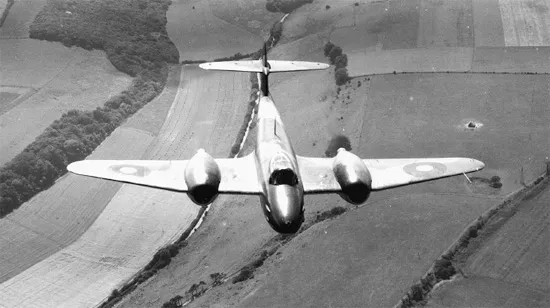
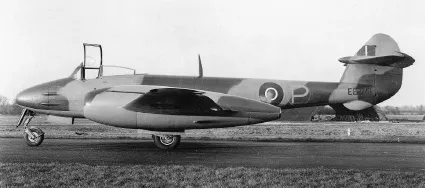
First flown in April 1944, Meteor F.1 EE211/G offers a reasonable view of the ‘short’ engine nacelles common to Welland-powered F.9/40s, production F.1s and all but the last fifteen production F.3s. Short nacelles created significant vibration which in turn imposed speed restrictions upon early Meteors. Thus, by March 1945 EE211/G had been experimentally fitted with longer nacelles that ultimately proved successful and were to become standard on the F.4. Tony Buttler collection
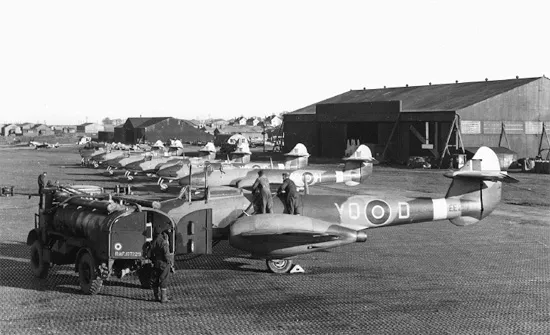
A familiar image showing Meteor F.1 s and F.3s of 616 Squadron in 1945. The nearest Meteor is F.1 EE219 ‘YQ-D’, while behind is F.3 EE235 ‘YQH’, the two Marks employing different style cockpit canopies. EE219 ‘YQ-D’ later became ‘YQ-N’ and then 5799M in January 1946, while EE235 went on to serve with 1335 CU and the CFE prior to becoming 5781M in 1946. Via Tony Buttler
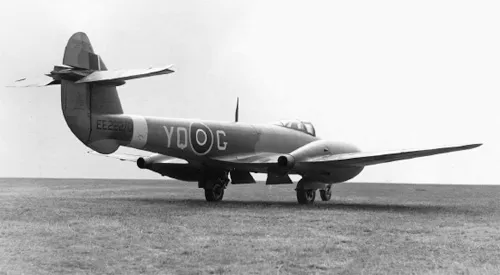
A rear-quarter view of 616 Squadron F.1, EE222/G ‘YQ-G’, photographed prior to 20 September 1944 – the day it force-landed at Plucksgutter, Kent, after it ran out of fuel. Via Tony Buttler
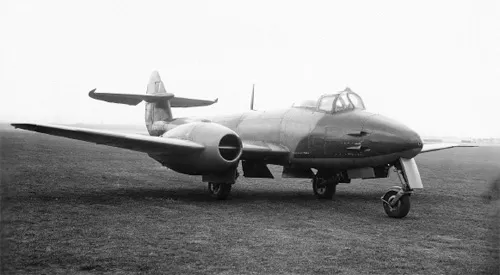
A front-quarter view of F.1, EE223. This airframe never entered RAF service, being retained instead for use by the manufacturer and the A&AEE until, in March 1945, it went to Rolls-Royce to trial the company’s RR W.2B/37 engine – better known today as the Derwent 1. EE223 was SOC in 1946. Tony Buttler collection
Meteor F.3
The Meteor F.1 was replaced on the production line by the more powerful Meteor F.3 with engines rated at 2,000 lb thrust each, giving the Mark a superior performance over not just its predecessors but its piston-engined contemporaries too. Eventually the F.3 would equip at least seventeen RAF squadrons – albeit not simultaneously it should be noted (see Appendix 1).
The F.3 was powered by the W.2B/37 engine, or the Derwent 1 as it would later be known, although the first fifteen airframes received the earlier Welland because, initially at least, airframe supply outstripped engine supply. EE230 was both the first F.3 and the first of its Mark to fly (in September 1944), while EE245 became the first Derwent-powered F.3. As related earlier, all except the last fifteen F.3s received short ‘pop-bottle’ engine nacelles – some of which were retrospectively fitted with long nacelles – while some had more powerful 2,400 lb thrust Derwent 4 engines fitted.

Meteor F.3, EE457 ‘ZD-Q’, belonging to 222 Squadron which received F.3s from October 1945. Originally retained by GAC, this Meteor is believed to have been involved in the development of the ‘long’ engine nacelle, although it wasn’t one of the fifteen long-nacelle production F.3s referred to earlier. Long-chord nacelles were first trialled by F.1, EE211, and it was discovered that they almost eliminated buffeting under most conditions – while at sea level (with 2,000 lb thrust engines) EE211’s speed increased by almost 60mph. EE457 was written-off on 7 October 1947. Roger Lindsay collection
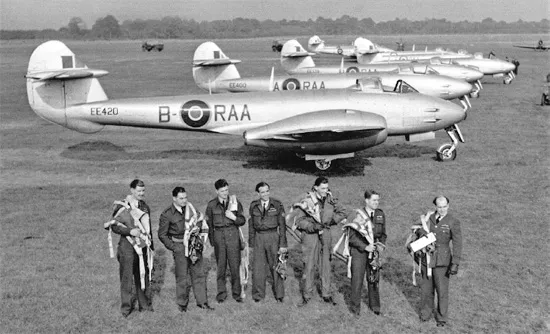
F.3, EE420 ‘RAA-B’, of 500 (County of Kent) Squadron circa 1948. 500 Squadron received its first Meteors in July 1948 and gradually replaced the unit’s Mosquito NF.30s over the ensuing months. Finished in High-Speed Silver overall (HSS), EE420, late of 222 Squadron, displays its Reserve Command code ‘RAA’ (‘R’ = Reserve) and individual letter ‘B’ followed by a hyphen which was applied to some of the unit’s F.3s but not all. Later recoded ‘S7-B’, EE420 left the Squadron in October 1951, three months after its first Meteor F.4s arrived. Following a period of storage it became 6968M in May 1952. Via Roger Lindsay
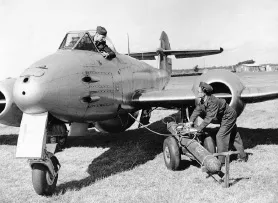
F.3, EE305 ‘RAA-H’, of 500 Squadron undergoing maintenance in 1949 complete with screwdriver lodged against the rim of the nose panel. Later coded ‘S7-H’, EE305 departed the unit in April 1950 and later served with 206 AFS. It was sold for scrap on 22 June 1956. Newark Air Museum
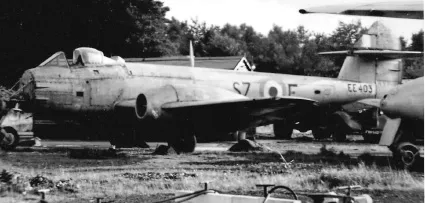
Somewhat beyond its prime, 500 Squadron F.3, EE403 ‘S7-E’, is seen in 1952 awaiting the scrap man. The unit code ‘S7’ (not ‘SZ’) replaced ‘RAA’ when RAuxAF fighter squadrons were transferred to Fighter Command in November 1949. Most of 500 Squadron’s Meteors presented their unit code forward of the roundel on the port side, although a known exception was F.3 EE460 ‘S7-V’, which had ‘S7’ placed aft of the roundel on both sides of the fuselage. Despite a few exceptions, two-character unit codes were generally discarded during 1951. Via Roger Lindsay
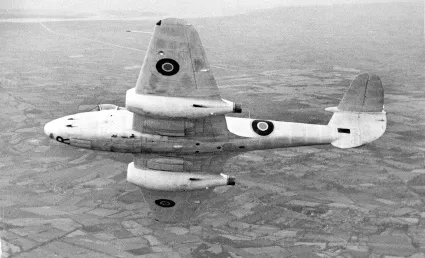
616 Squadron Meteor F.3, EE240 ‘YQ-R’ seen while operating over the Continent in 1945. Painted white as a precaution against being misidentified as a Luftwaffe jet. Tony Buttler collection
As with the F.1, 616 Squadron became the first operational unit to receive the F.3 commencing in the last days of 1944 and into January 1945. Sent to the continent, it was hoped they might engage the Luftwaffe’s much-vaunted jets, particularly the Me 262, but, to the mortification of historians and enthusiasts ever since Hitler’s jets proved elusive and no such combat occurred.
The Meteor F.3 remained in operational service in diminishing numbers until 1951, when the last two F.3-equipped front line units, Nos.500 and 616 Squadrons Royal Auxiliary Air Force (RAuxAF), received the Meteor F.4 which had begun to equip Regular RAF Fighter Command squadrons from 21 December 1947. Thereafter, some F.3s continued in use as advanced trainers, notably with Nos.205, 206 and 210 Advanced Flying Schools (AFS) into 1954.

Following wartime service with 616 Squadron as ‘YQ-H’, F.3 EE236, went on to serve with 1335 CU and then the Empire Central Flying School, coded ‘B’. In 1946, Flying Training Command introduced a new three-letter unit code system in which ECFS Meteor F.3s, F.4s and Spitfire 9s were all coded ‘FCW’ (plus their individual code letters). It seems highly improbable though that EE236 could have received such a code given it became 5786M on 12 January...
Table of contents
- Cover
- Title
- CONTENTS
- Copyright
- Preface
- The Gloster F.9/40
- Meteor F.1
- Meteor F.3
- Meteor F.4
- Meteor T.7
- Meteor F.8
- Photographic Reconnaissance
- The Night Fighters: NF.11/13 & 12/14
- Targets, Tugs and RN Meteors
- British Meteor Miscellany
- CEV Flight Test Centre Meteors
- Meteor camouflage and markings
- The Meteor in Colour
- Modelling the Meteor
- Appendices